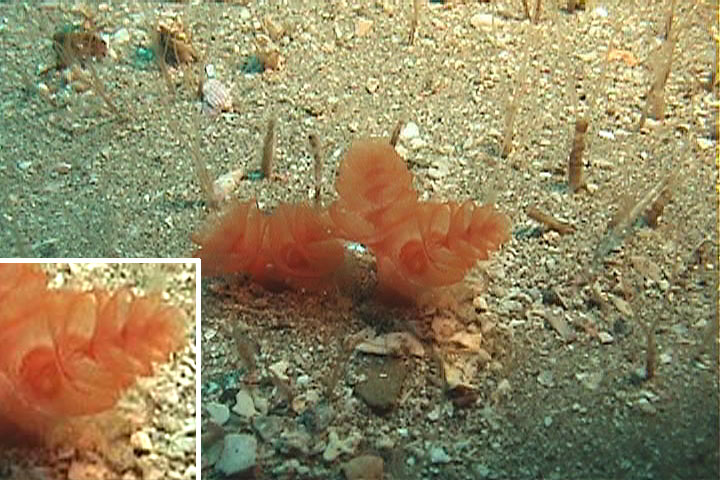

Most divers cruising the depths of the Casino Dive Park are totally oblivious to one of the more common species on the sandy bottom. If one looks carefully, they can see dozens of very small (about 1" tall) orange-tinged projections above the sand's surface. One species found off central California may have as many as 1,200 individuals in a square meter (a little more than a square yard). If you focus a dive or camera light on them, you can see they are actually bright orange. At the depths they are found, phoronids live in an environment almost entirely stripped of the sun's orange light so there is little to reflect back to the human eye without an artificial light source.
This is a small group (phylum) with only 12-16 known species. Phoronids are also known as "horseshoe worms" due to the shape of their feeding structures. They are benthic infauna, that is phoronids live buried in the sand, mud or fine gravel on the ocean floor. Their home consists of a small chitinous tube. They may be found in depths up to nearly 1,500 feet but are most common above 200 feet. Although they have a simple nervous system, these animals can quickly retract their bodies into their tubes if threatened by a potential predator.
Phoronids are suspension feeders. They collect food using a structure known as a lophophore. This is a ring of tentacles that surround the mouth. Cilia on the lophophore create a steady current of water bringing food. They also orient their lophophores in the direction of underwater currents. Their digestive tracts differ from those of true worms which are straight with the mouth at one end and the anus at the other. Phoronids have u-shaped digestive tracts with their anus opening at the same end as the mouth. This is probably a result of the fact they live in tubes. Some distantly related groups enclosed both their mouths and their anus in the feeding lophophore. I think you can see why this might not have been one of the "bright ideas" of evolution.
Some phoronids reproduce sexually with male and female partners, others are hermaphroditic with each individual possessing both sex organs. Some are said to reproduce asexually as well. Not a lot of fun, but it makes it easy to expand your population, especially if it starts with only one! The larvae are free swimming, and therefore may disperse to enable phoronids to colonize new areas.
Now I'm not saying phoronids are one of the really significant species in our local marine ecosystems like giant kelp or sheephead. However, they are fairly abundant and must fill an ecological niche or role of some significance. In my research I have found relatively little information about them. Sounds like a candidate for further research. Time to peck at the computer keys and write a fancy grant to the National Science Foundation to support such a study. After all, some agencies have funded far more absurd projects and I'm a very deserving scientist (in my own mind!).
As I write this, I'm preparing to fly back to Florida for the second time this spring. No, I'm not off on another diving adventure although dive buddies in Florida suggested one. My father is seriously ill so I'm going back to take care of two very important people in my life, my parents. Thanks to their efforts at reproducing our species, I was created (it may have happened to the music of the Big Bands in the Casino broadcast in Chicago over CBS)! If I miss a column while I'm gone, I'm sure you will understand. We all go through and can relate to such times... well, unless you're a phoronid.
© 2004 Dr. Bill Bushing. Watch the "Dive Dry with Dr. Bill" underwater videos on Catalina Cable TV channel 49, 10:00 AM and 5:00 PM weekdays.

Phoronids on the sandy bottom of the Dive Park with
lophophores extended
(inset: slightly enlarged image of
lophophore).
This document maintained by
Dr. Bill Bushing.
Material
© 2004 Star Thrower Educational Multimedia